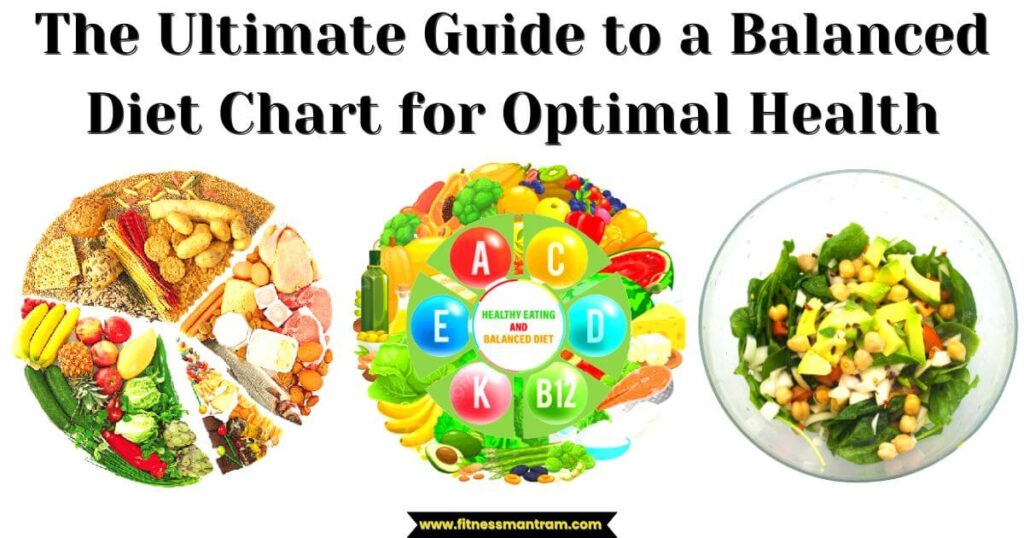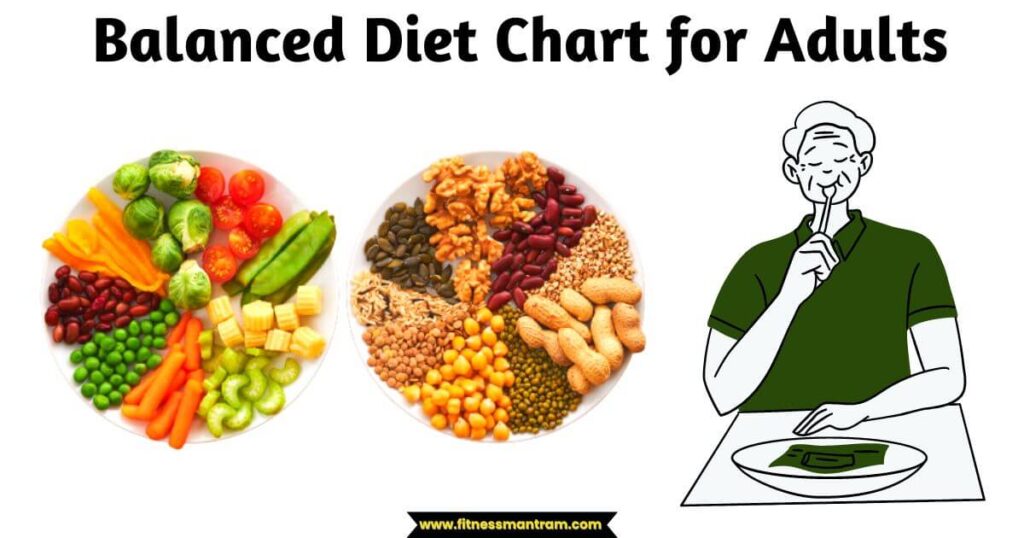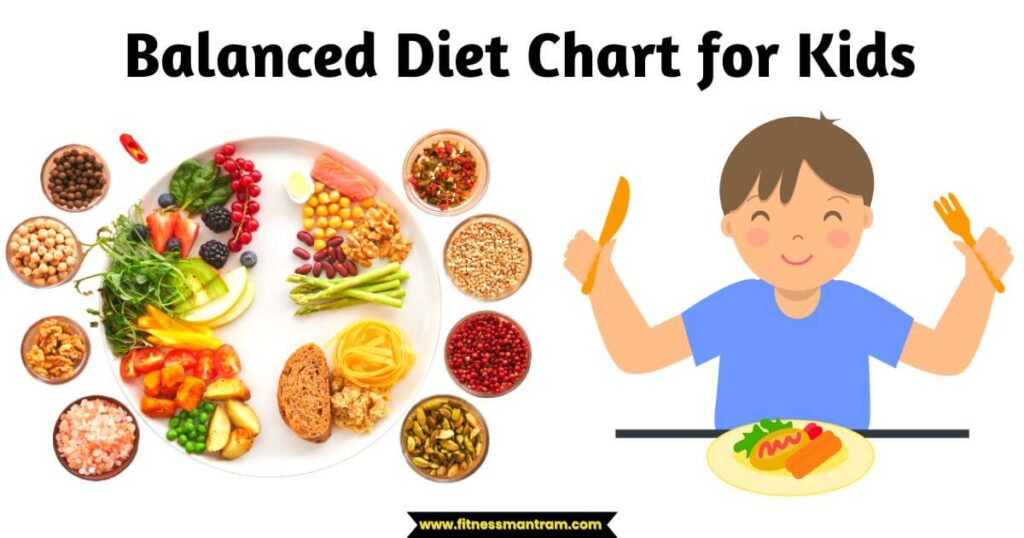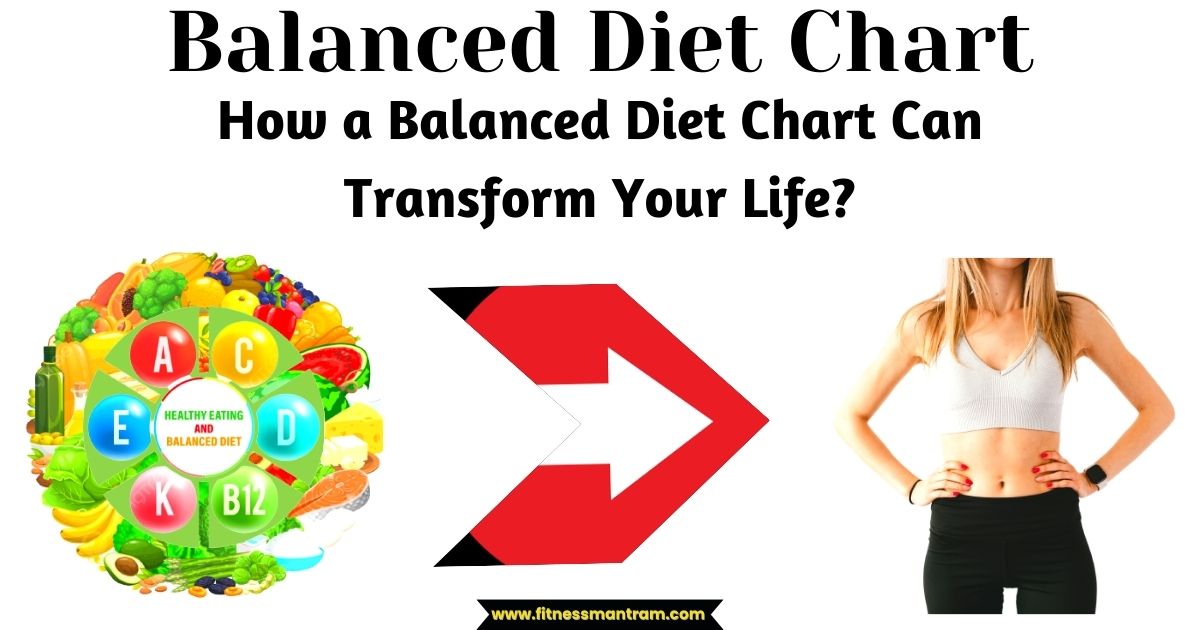The Ultimate Guide to a Balanced Diet Chart for Optimal Health: Learn the secrets of a Balanced Diet Chart that will helps and promotes optimal health and your fitness. This article will provide you with an expert insights, engaging content, and actionable tips that will help you to achieve a balance between your delicious foods and nutritional needs as required by your body. Read on to the full article to learn how a unique balanced diet chart can transform your life and take you on a right path to maintain good health and fitness.

Introduction
Welcome to the ultimate guide on achieving a balanced diet chart that will aide on accomplishing your health and make your taste buds sing with delight! Are you tired of all those fad diets that promising quick result? If yes! Don’t worry you’re in luck because in this article we are about to embark on a journey towards sustainable nutrition that is supported by science and tailored to your specific need and requirements towards fitness journey.
The importance of eating a healthy balanced diet and how it can help you to improve your overall health and fitness are the main topics which we are going to cover in this article. We will give you easy and simple tips, some good delicious example and interesting facts along the way. So, let’s get started to learn the secret of balanced diet chart in this article.
The Key Components of a Balanced Diet Chart
The necessary and essential nutrients that our body requires for proper functioning are included in a balanced diet chart. By including the appropriate and required quantity of proteins, carbohydrates, fats, vitamins, minerals, and fibre in your daily intake of balanced diet, you can easily provide with the necessary energy as it required to work throughout the day so, let’s begin to take a have a closer look at each of the following components.
Proteins – The Building Blocks of Life
Proteins are the superheroes in our daily eating routine, which are responsible for the development, repair and maintenance of our body’s tissues. Our bodies also use proteins to help regulate hormones, make enzymes, and work the immune system. To have good health, it is important to include fish, vegetable, meat and dairy items in your regular diet, these products are good resources of high and good quality of protein.
Carbohydrates – The Energy Powerhouses
Our body need carbohydrates which is important fuel as required by the body, these carbohydrates give us the energy as required to carry out your day-to-day activities. However, not all the carbs which are created do the same function. The whole grains, fruits, vegetables, and legumes which are the examples of complex carbohydrates that help us feel fuller for longer. We should avoid eating excessive of refined sugars and processed foods as these can cause energy crashes which result in weight gain.
Fats – The Good, the Bad, and the Essential
According to popular belief, all fats are not harmful to you, Healthy fats are an essential part of a balanced diet chart and can actually support heart health, brain function, and hormone production. Flaxseeds, fatty fish and chia seeds are form of polyunsaturated fats, Olive oil, nuts and avocados are form of monosaturated fats, both these types of fats form should also be included. Limit your intake of saturated and trans fats found in fried foods, pastries, and processed snacks.
Vitamins and Minerals – The Micronutrient Heroes
Even though minerals and vitamins are available in small quantity, they have a great effect on overall health. These micronutrients perform as co-factors in different biochemical responses, confirming that your body works properly. If you want to have a wide variety of minerals and vitamins in your diet, then it is necessary for you to eat a diet which includes a variety of fruits, vegetables, nuts, seeds, whole grains, and other foods.
Fiber – The Gut’s Best Friend
Fiber is the unsung hero of digestion, promoting bowel regularity, lowering cholesterol levels, and maintaining a healthy weight. If you eat plenty of protein from whole grains, legumes, nuts, fruits, and vegetables you feel better and you will remain active throughout the day. Since we had now covered the essential components of a balanced diet. Let’s move on to creating your very own diet chart that incorporates these elements in the right proportions so as to keep our fitness.
Crafting Your Personalized Balanced Diet Chart
Step 1: Determine Your Caloric Needs
To start first calculate your daily caloric intake with respect to your age, gender, daily activity and your fitness goal. This information will help you in much better way at the time of designing your balanced diet chart. To calculate your daily calorie consumption, you can use online calculators and apps in estimating your calorie requirements.
Before creating a personalized balanced diet chart, it is necessary to consider your nutritional requirement, preference and your lifestyle. Therefore, while a diet plan you should remember your goal is to maintain a good balance between the food that you enjoy and the vitamin that your body requires to be healthy. To begin in proper way just follow the step as given below.
Step 2: Distribute Macronutrients
Once you have your calorie target, it’s time to allocate macronutrients in your diet chart. You should try to achieve at least 65%–45% of calories from carbohydrates, 20%–35% from fats, and 15% –20% from proteins. Remember to prioritize complex carbohydrates, healthy fats, and lean sources of protein.
Step 3: Embrace Variety and Color
Now comes the fun part! Fill your diet chart with a diverse array of nutrient-dense foods. Include a rainbow of fruits and vegetables to ensure a wide range of vitamins and minerals. Experiment with whole grains, such as quinoa, brown rice, and oats, for your carbohydrate sources. Incorporate lean proteins like chicken breast, fish, tofu, and legumes. Don’t forget to add some solid fats like avocados, olive oil, and nuts.
Step 4: Portion Control and Mindful Eating
Including a variety of foods is important similarly portion control is also important for keeping a healthy diet. Be thoughtful before serving sizes and always listen to your body’s hunger and fullness cues. The way that you eat and what you eat both are essential, therefore take your time, chew your meal completely, and experience the flavours and pleasures of each bite.
Step 5: Hydration and Healthy Habits
Hydration is mainly overlooked, but it is very important to maintain overall health. Therefore, to keep your body hydrated, you should drink plenty of water this will in support healthy digestion. Secondly adopt healthy habits like regular physical activity, getting enough sleep, and managing stress to complement your balanced diet.
Balanced Diet Chart for Adults
To maintain optimum health by preventing chronic diseases with the help of supporting energy level it is important to create a healthy balanced diet chart for adults. A balanced diet consists of a various type of nutrient-dense foods from different food groups. Given below is a guideline for preparing a balanced diet chart for adults.

- Breakfast: To get energy and fiber it is necessary to include the source of whole grains like oatmeal, whole grain cereal or grain bread. To support muscle repair and satiety add lean protein such as eggs, tofu or Greek yogurt. To get sufficient number of vitamins, minerals and antioxidants incorporate fruits and vegetable either as a side or in a form of smoothie.
- Morning Snack: To provide additional nutrients and to satisfy your hunger choose a healthy snack option by taking handful of nuts, seeds or pieces of fruits. To remain hydrated you can drink water, herbal tea or sugarless beverages.
- Lunch: Fill half of your plate with a variety of colourful vegetables, both raw and cooked, for fiber, vitamins, and minerals. Include a lean protein source, such as grilled chicken, fish, beans, or lentils, to support muscle health and satiety. Add a serving of entire grains, as quinoa, brown rice, or entire wheat pasta, for supported energy and fibre. Use healthy fats, like avocado, olive oil, or nuts, in moderation for flavor and essential nutrients.
- Afternoon Snack: Opt for a balanced snack, such as Greek yogurt with berries, hummus with vegetable sticks, or a small portion of whole grain crackers with cheese. Stay hydrated by drinking water, infused water, or herbal tea.
- Dinner: Make half of your plate vegetables, including a mix of leafy greens, cruciferous vegetables, and other colorful options. Pick a lean protein source, similar to fish, lean meats, poultry, or plant-based choices like tempeh or tofu. Incorporate whole grains or starchy vegetables, such as sweet potatoes or quinoa, for sustained energy and fibre. Flavor meals with herbs, spices, and healthy sauces instead of relying on excessive salt or sugar.
- Evening Snack: Enjoy a light and nutritious snack, such as a small bowl of Greek yogurt with sliced fruits, a handful of mixed nuts, or a homemade energy bar. Hydrate with water, herbal tea, or decaffeinated beverages.
Important Considerations
- Portion Control: Pay attention to portion sizes to maintain a healthy weight and avoid overeating.
- Hydration: To stay and keep your body hydrated throughout the day drink plenty of water and sugar free beverages. Limit the consumption of sugary drinks.
- Variety and Colors: Include a wide variety of fruits and vegetables of different colors to ensure a diverse range of nutrients.
- Healthy Fats: A healthy balance of essential vitamins and minerals are achieved with the help of avocados, nuts, seeds, and olive oil which are good sources of healthy fats.
- Mindful Eating: Practice mindful eating by savoring your meals, listening to your body’s hunger and fullness cues, and avoiding distractions. Keep in mind, individual nutritional requirement is different due their age, sex, day to day activity and their health conditions. Consult with a registered dietitian for personalized guidance and to address any specific dietary concerns or restrictions. The main purpose of a balanced diet chart for adults is promotes overall health and lowers the risk of chronic diseases.
Balanced Diet Chart for Kids
For children’s growth, development, and to maintain overall health, it is essential to create a balanced diet chart for kids. It’s important to provide them with a variety of nutrients while considering their specific nutritional needs and preferences. Here’s a guideline for crafting a balanced diet chart for kids.

- Breakfast: Include whole grain cereals or bread for a good source of carbohydrates and fibre. For calcium and protein, provide a serving of dairy or dairy alternatives like yogurt, cheese, or milk. Add fruits or fruit juices for essential vitamins and minerals.
- Morning Snack: Sliced fruit, a few nuts, or a homemade granola bar are all good options for healthy snacks. Encourage water or a small portion of unsweetened fruit juice for hydration.
- Lunch: Take different types of vegetables like carrots, cucumbers or bell peppers in the form of sandwich as a side dish. Include a lean protein source, like grilled chicken, turkey, tofu, or legumes, for growth and repair. Add whole grain options like brown rice, whole wheat pasta, or whole grain bread for fiber. Offer a small portion of healthy fats from sources like avocado, olive oil, or nut butter.
- Afternoon Snack: Provide a combination of protein and carbohydrates, such as a yogurt with fresh berries, whole grain crackers with cheese, or a homemade smoothie. Encourage water or diluted fruit juice for hydration.
- Dinner: Prioritize a balanced plate with a serving of vegetables, such as broccoli, spinach, or sweet potatoes. Include a lean protein source, like fish, chicken, lean beef, or plant-based alternatives. Incorporate whole grains, like quinoa, whole wheat couscous, or whole grain pasta, for sustained energy. Introduce a variety of flavours and spices to expand their taste preferences.
- Evening Snack: Offer a light and nutritious option, such as a small bowl of yogurt with sliced fruits, a handful of trail mix, or a whole grain muffin. Encourage water or milk for hydration.
Balanced Diet Chart with Names
Here is a balanced diet chart with food group names to help you create a well-rounded and nutritious meal plan
- Food Group – Grain: Whole wheat bread, Brown rice, Quinoa, Oats, Barley, Whole grain pasta, Millet.
- Food Group – Fruits: Apples, Bananas, Oranges, Kiwi, Grapes, Pineapple.
- Food Group – Vegetables: Leafy greens (spinach, kale, lettuce), Broccoli, Carrots, Bell peppers, Tomatoes, Cucumbers, Cauliflower.
- Food Group- Protein: Chicken breast, Salmon, Tofu, Lentils, Beans (black beans, kidney beans), Greek yogurt, Eggs.
- Food Group- Dairy Products : (cow’s milk, almond milk), Yogurt (Greek yogurt, plain yogurt), Cheese (cheddar, mozzarella), Cottage cheese.
- Food Group – Beverages: Water, Herbal tea, Unsweetened fruit juice, green tea, Smoothies (made with fruits and vegetables).
- Food Group- Healthy Fats: Avocado, Olive oil.
Other Items
- Different type of Berries like strawberries, blueberries, raspberries.
- Nuts: Walnuts, cashews, almonds.
- Seeds (chia seeds, flaxseeds).
- Types of nut butter such as peanut butter, almond butter.
Remember to incorporate foods from each food group into your meals to ensure a balanced and diverse nutrient intake. This chart may be used as a starting point while creating a healthy food plan, but you can make changes according to your requirement and nutritional needs. Consulting with a registered dietitian can provide personalized guidance for your specific nutritional requirements.
Pros and Cons of Balanced Diet chart
A balanced diet chart offers numerous benefits for overall health and well-being. Before integrating it in to your daily lifestyle, it is important to know about pros and cons of a balanced diet chart. Let’s explore the pros and cons of a balanced diet chart:
Pros of a Balanced Diet Chart
- Nutritional Adequacy: The main purpose of taking a well-balanced diet is to make sures that you get wide range of foods require by your body with the necessary vitamins, minerals and nutrients for keeping and maintaining it in good health.
- Weight Management: If you have a specific goal to reduce weight, maintain and control weight, or to gain weight than a personalized balanced diet chart will help you to reach your goals by incorporating the required amounts of macronutrients as required by your body and also by encouraging portion control.
- Improved Energy Levels: A well-balanced diet is necessary, because it acts as fuel of our body by providing the energy, we that we need to remain active, focused, energetic and productive throughout the day.
- Disease Prevention: One of the most important benefits of taking a well-balanced diet which are high in fruits, vegetables, whole grains, and lean proteins is that it may help to reduce the risk of chronic diseases like diabetes, heart disease, stress, and some types of cancer.
- Gut Health: A balance diet which contain food with high amount of fibre will help us to Keep and maintain healthy digestive system, diverse gut microbiome, and to prevent constipation.
- Mental Well-being: Mental health depends upon diet, so to improve your mood, memory, and overall mental health eating a healthy balanced diet is important.
- Long-Term Sustainability: When compared to restrictive diets, a balanced diet chart allows you to eat a wide variety of foods without feeling deprived and encourages a long-term approach to nutrition.
Cons of a Balanced Diet Chart:
- Individual Variations: Nutritional requirements may vary from person to person which is based upon their age, gender, level of activity, and health conditions. A specific size that suits someone should not be consider as a same dietary requirement for all.
- Time and Planning: It may be a challenging for many people to have fresh and healthy food due to their busy schedule, as maintaining a balanced diet chart requires planning, preparation, and conscious food choices.
- Cost: It is also a one of the important factors as some nutrient-dense foods are expensive than processed or unhealthy alternatives. Adhering to a balanced diet may require additional financial resources for purchasing high-quality ingredients.
- Social Challenges: Following a balanced diet chart can be challenging in social situations or when dining out, as it may limit food choices and require navigating menus carefully.
- Allergies and Dietary Restrictions: Individuals with allergies or dietary restrictions may face additional challenges in finding suitable alternatives and ensuring a balanced intake of nutrients.
Despite the potential cons, the benefits of a balanced diet chart far outweigh the challenges. Any individual who follows the balance diet in their routine can get benefited from the advantage of this diet. Get advice from professional dietician if required and make the changes in your diet according to your goal.
Conclusion
Congratulations! This comprehensive guide to create a personalized balanced diet chart has reached to its conclusion part. Hence by including these important key components of proteins, carbohydrates, fats, vitamins, minerals, and fiber in your daily consumption you can achieve your optimal health and fitness.
Remember that following healthy diet routine doesn’t require starving yourself or complying with severe guidelines. Finding a sustainable way to nourish your body while enjoying your favourite foods be your goal. In this way, with the information and knowledge that you’ve acquired will help you to be creative in the kitchen, which will embark your journey towards a healthier and happier you!
Frequently Asked Questions
Q1: Can I indulge in my favourite treats while following a balanced diet?
The main purpose is moderation and portion control, if you can follow this, then absolutely you can enjoy your favourite treats occasionally, savouring them mindfully, and ensuring they fit into your overall calorie and nutrient goals. Hence, we can say a balanced diet allows for flexibility that includes room for indulgences
Q2: How long does it take after a balanced diet begin to give results?
Depending upon the individual current health state, sex and the type of diet they follow, the advantages of eating a well-balanced diet may vary from person to person. While some people may notice a change in energy and overall wellness within a few weeks, others might require more time. Keep in mind that consistency is key, and the best results come from by making a routine habit of taking a balance diet in your daily lifestyle.
Q3: Are there any particular diets that are considered to be balanced?
A balance diet is a form of diet that basically focuses on overall nutritional balance rather than as compared to other diet plans. Though popular diets like the Mediterranean diet, the DASH diet, and vegetarian/vegan diets can provide a balanced approach to nutrition, it is essential to alter and follow to the diet according to your specific requirements and needs. Speaking to a registered dietitian can help you create a personalized well balanced diet plan.
Q4: Can a balanced diet help with weight loss?
Absolutely! A balanced diet may help you to reduce your weight as it provides the required nutrients by maintaining a proper calorie deficit. It also helps you to maintain and control your weight if you make a habit of taking whole nutrient-dense foods as your first priority and by limiting it to other diet. Remember, to get better result along with your balanced diet you also need to do regular physical exercise.
Q5: Is it necessary to keep track of calories when eating a healthy diet?
Calorie counting isn’t always necessary when eating a balanced diet. If you are planning to achieve a specific fitness goal then this particular process to keep track of calories intake will serve you as useful tool which will help you to control and maintain your weight. Keeping record of your calorie’s intake will help you to stay on track with your calorie goals and will motivative you to continue the process. It is important to remember, quality of the calories that you take also matter, so you need to keep your focus on the nutrients available in the food rather than just how many calories they contain.
Q6: Can a balanced diet help prevent chronic diseases?
Yes, taking a well-balanced diet is important because it plays a big role in preventing the diseases like diabetes, heart disease, and some tumours by providing essential nutrients, antioxidants, and carbohydrates. The other important component of a balanced lifestyle also includes regular exercise, adequate sleep, and stress management. It is necessary to remember that a balanced diet has a number of other different elements, out of which one is a good diet.
Q7: How often should I modify my balanced diet chart?
The need to make changes in your balanced diet chart mostly depends upon your lifestyle, weight goals and changes in your health status. It is advisable to access your diet especially if there is change in your lifestyle. A professional and registered dietitian can give you supportive guidance and guarantee that you’re eating routine arrangement is as per your ongoing necessities.
Q8: Can I eat a balanced diet if I have allergies or dietary restrictions?
Absolutely! A balanced diet can be adjusted accordingly with respect to dietary limitations or allergies. You can create a balanced diet chart that meets your specific requirements with the help of a registered dietitian. It is necessary to make sure that you get all the essential nutrients from other different food resources to keep and maintain your balanced nutrition as required.
Q9: Are supplements necessary for a balanced diet?
Generally speaking, a balanced diet can give all the required essential nutrients to have good health. In some cases, to overcome nutrients deficiencies supplements are recommended by health care professional. It is always recommended that before starting any new exercise routine or if you’re planning to take any dietary supplement, it is important to consult with your family physician or with a medical expert professional to make sure that you had started your health and fitness journey in a right direction.
Q10: Can children and teenagers follow a balanced diet?
Absolutely! In fact, because they undergo through vital stages of growth and development, kids and teens need to eat well. To maintain their growth, education and overall health make sure to give them all the required nutrients through a balanced diet made up of a variety of foods. Paediatrician or qualified dietitian is a better option for nutritional advice.
Q11: Can a balanced diet chart help me lose weight?
A: Yes, a balanced diet chart can support weight loss by promoting healthy eating habits and providing adequate nutrition while controlling calorie intake.
You May Also Like
- The Truth About Tea Burn In 3 Minutes
- 10 Trendy Ways To Improve Your Fitness.
- A Simple Yet Effective Flat Belly Tonic
Disclaimer : The details & information given here in this article is based on information as available on other published site on internet. Do take medical advice before adopting it. Fitness Mantram Does Not Confirm It. This site contains affiliate links. If you choose to make a purchase after clicking a link the author/owner/creator may receive a commission at no ADDITIONAL cost to you. Thank you for your support!
